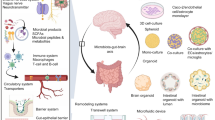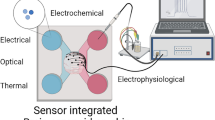Abstract
Three-dimensional cultures have exciting potential to mimic aspects of healthy and diseased brain tissue to examine the role of physiological conditions on neural biomarkers, as well as disease onset and progression. Hypoxia is associated with oxidative stress, mitochondrial damage, and inflammation, key processes potentially involved in Alzheimer’s and multiple sclerosis. We describe the use of an enzymatically-crosslinkable gelatin hydrogel system within a microfluidic device to explore the effects of hypoxia-induced oxidative stress on rat neuroglia, human astrocyte reactivity, and myelin production. This versatile platform offers new possibilities for drug discovery and modeling disease progression.




Similar content being viewed by others
References
J.C. Pettersen and S.D. Cohen: The effects of cyanide on brain mitochondrial cytochrome oxidase and respiratory activities. J. Appl. Toxicol. 13, 9 (1993).
M.L. Block, L. Zecca, and J.-S. Hong: Microglia-mediated neurotoxicity: uncovering the molecular mechanisms. Nat. Rev. Neurosci. 8, 57 (2007).
S. Holmes, M. Singh, C. Su, and R.L. Cunningham: Effects of oxidative stress and testosterone on pro-inflammatory signaling in a female rat dopaminergic neuronal cell line. Endocrinology 157, 2824 (2016).
B. Snyder, B. Shell, J.T. Cunningham, and R.L. Cunningham: Chronic intermittent hypoxia induces oxidative stress and inflammation in brain regions associated with early-stage neurodegeneration. Physiol. Rep. 5, e13258 (2017).
E. Rybnikova and M. Samoilov: Current insights into the molecular mechanisms of hypoxic pre- and postconditioning using hypobaric hypoxia. Front. Neurosci. 9, 388 (2015).
D. van der Vlies, M. Makkinje, A. Jansens, I. Braakman, A.J. Verkleij, K.W. Wirtz, and J.A. Post: Oxidation of ER resident proteins upon oxidative stress: effects of altering cellular redox/antioxidant status and implications for protein maturation. Antioxid. Redox Signal. 5, 381 (2003).
S.S.K. Cao and J. Randal: Endoplasmic reticulum stress and oxidative stress in cell fate decision and human disease. Antioxid. Redox Signal. 21, 396 (2014).
A.J. Majmundar, W.J. Wong, and M.C. Simon: Hypoxia-inducible factors and the response to hypoxic stress. Mol. Cell 40, 294 (2010).
X. Zhang and W. Le: Pathological role of hypoxia in Alzheimer’s disease. Exp. Neurol. 223, 299 (2010).
F. Zhang, L. Niu, S. Li, and W. Le: Pathological impacts of chronic hypoxia on Alzheimer’s disease. ACS Chem. Neurosci. 10, 902 (2019).
R. Yang and J.F. Dunn: Multiple sclerosis disease progression: contributions from a hypoxia-inflammation cycle. Mult. Scler. J. 25, 1715 (2019).
S. Pedron and B.A.C. Harley: Editorial: biomaterials for brain therapy and repair. Front. Mater. 5, 67 (2018).
P. Zhuang, A.X. Sun, J. An, C.K. Chua, and S.Y. Chew: 3D neural tissue models: from spheroids to bioprinting. Biomaterials 154, 113 (2018).
A.M. Hopkins, E. DeSimone, K. Chwalek, and D.L. Kaplan: 3D in vitro modeling of the central nervous system. Prog. Neurobiol. 125, 1 (2015).
H. Lassmann, W. Bruck, and C.F. Lucchinetti: The immunopathology of multiple sclerosis: an overview. Brain Pathol. 17, 210 (2007).
M. Filippi, A. Bar-Or, F. Piehl, P. Preziosa, A. Solari, S. Vukusic, and M.A. Rocca: Multiple sclerosis. Nat. Rev. Dis. Primers 4, 43 (2018).
C. Cui: Engineering heme-copper and multi-copper oxidases for efficient oxygen reduction catalysis, PhD thesis, University of Illinois at Urbana-Champaign (2018).
K.M. Park and S. Gerecht: Hypoxia-inducible hydrogels. Nat. Commun. 5, 4075 (2014).
L.-S. Wang, C. Du, J.E. Chung, and M. Kurisawa: Enzymatically cross-linked gelatin-phenol hydrogels with a broader stiffness range for osteogenic differentiation of human mesenchymal stem cells. Acta Biomater. 8, 1826 (2012).
S. Pedron, E. Becka, and B.A.C. Harley: Regulation of glioma cell phenotype in 3D matrices by hyaluronic acid. Biomaterials 34, 7408 (2013).
M.R. Blatchley, F. Hall, S. Wang, H.C. Pruitt, and S. Gerecht: Hypoxia and matrix viscoelasticity sequentially regulate endothelial progenitor cluster-based vasculogenesis. Sci. Adv. 5, eaau7518 (2019).
S. Rammensee, M.S. Kang, K. Georgiou, S. Kumar, and D.V. Schaffer: Dynamics of mechanosensitive neural stem cell differentiation. Stem Cells 35, 497 (2017).
C.M. Madl, B.L. LeSavage, R.E. Dewi, K.J. Lampe, and S.C. Heilshorn: Matrix remodeling enhances the differentiation capacity of neural progenitor cells in 3D hydrogels. Adv. Sci. 6, 1801716 (2019).
M. Dong, D.P. Spelke, Y.K. Lee, J.K. Chung, C.-H. Yu, D.V. Schaffer, and J.T. Groves: Spatiomechanical modulation of EphB4-ephrin-B2 signaling in neural stem cell differentiation. Biophys. J. 115, 865 (2018).
A. Farrukh, S. Zhao, and A. del Campo: Microenvironments designed to support growth and function of neuronal cells. Front. Mater. 5, 62 (2018).
C.M. Madl, B.L. LeSavage, R.E. Dewi, C.B. Dinh, R.S. Stowers, M. Khariton, K.J. Lampe, D. Nguyen, O. Chaudhuri, A. Enejder, and S.C. Heilshorn: Maintenance of neural progenitor cell stemness in 3D hydrogels requires matrix remodelling. Nat. Mater. 16, 1233 (2017).
B.M. Babior: NADPH oxidase. Curr. Opin. Immunol. 16, 42 (2004).
J. De Keyser, J.P. Mostert, and M.W. Koch: Dysfunctional astrocytes as key players in the pathogenesis of central nervous system disorders. J. Neurol. Sci. 267, 3 (2008).
T.N. Bhatia, D.B. Pant, E.A. Eckhoff, R.N. Gongaware, T. Do, D.F. Hutchison, A.M. Gleixner, and R.K. Leak: Astrocytes do not forfeit their neuroprotective roles after surviving intense oxidative stress. Front. Mol. Neurosci. 12, 87 (2019).
S.A. Liddelow and B.A. Barres: Reactive astrocytes: production, function, and therapeutic potential. Immunity 46, 957 (2017).
H. Lassmann: Hypoxia-like tissue injury as a component of multiple sclerosis lesions. J. Neurol. Sci. 206, 187 (2003).
J.R. Plemel, W.-Q. Liu, and V.W. Yong: Remyelination therapies: a new direction and challenge in multiple sclerosis. Nat. Rev. Drug Discov. 16, 617 (2017).
F. Wang, Y.-J. Yang, N. Yang, X.-J. Chen, N.-X. Huang, J. Zhang, Y. Wu, Z. Liu, X. Gao, T. Li, G.-Q. Pan, S.-B. Liu, H.-L. Li, S.P.J. Fancy, L. Xiao, J.R. Chan, and F. Mei: Enhancing oligodendrocyte myelination rescues synaptic loss and improves functional recovery after chronic hypoxia. Neuron 99, 689 (2018).
L.N. Russell and K.J. Lampe: Oligodendrocyte precursor cell viability, proliferation, and morphology is dependent on mesh size and storage modulus in 3D poly(ethylene glycol)-based hydrogels. ACS Biomater. Sci. Eng. 3, 3459 (2017).
Acknowledgments
The authors acknowledge Dr. Austin Cyphersmith (IGB, University of Illinois) for the assistance with fluorescence imaging, Mai Ngo for the assistance with microfluidic chips, and Zona Hrnjak and Aidan Gilchrist for the compression testing methodology and the custom MATLAB code for modulus analysis. The authors gratefully acknowledge support from the Scott H. Fisher IGB Graduate Student Research Fund. Research reported in this publication was supported by the National Cancer Institute of the National Institutes of Health (NIH) under Award Number R01 CA197488, the National Institute of Diabetes and Digestive and Kidney Diseases of the National Institutes of Health under Award Number R01 DK099528, as well as the Chemical Transformations Initiative at Pacific Northwest National Laboratory (PNNL) under the Laboratory Directed Research and Development Program at PNNL, a multiprogram national laboratory operated by Battelle for the U.S. Department of Energy (DOE). The content is solely the responsibility of the authors and does not necessarily represent the official views of the NIH or the DOE. The authors are also grateful for additional funding provided by the Department of Chemical & Biomolecular Engineering and the Carl R. Woese Institute for Genomic Biology at the University of Illinois at Urbana-Champaign.
Author information
Authors and Affiliations
Corresponding author
Additional information
These authors contributed equally to this work.
Electronic supplementary material
Rights and permissions
About this article
Cite this article
Zambutot, S.G., Serranot, J.F., Vilbert, A.C. et al. Response of neuroglia to hypoxia-induced oxidative stress using enzymatically crosslinked hydrogels. MRS Communications 10, 83–90 (2020). https://doi.org/10.1557/mrc.2019.159
Received:
Accepted:
Published:
Issue Date:
DOI: https://doi.org/10.1557/mrc.2019.159




